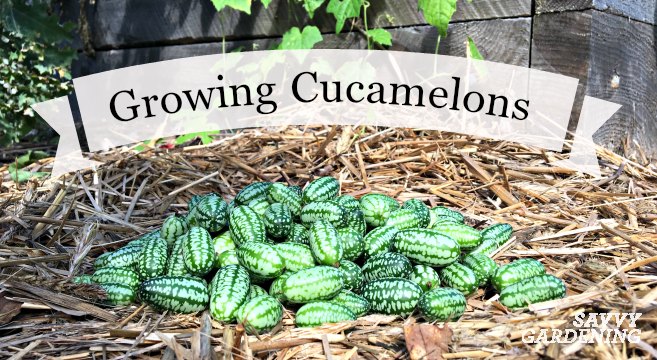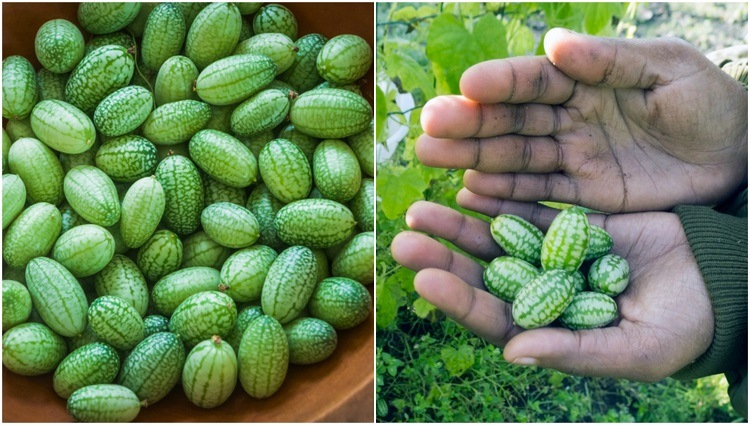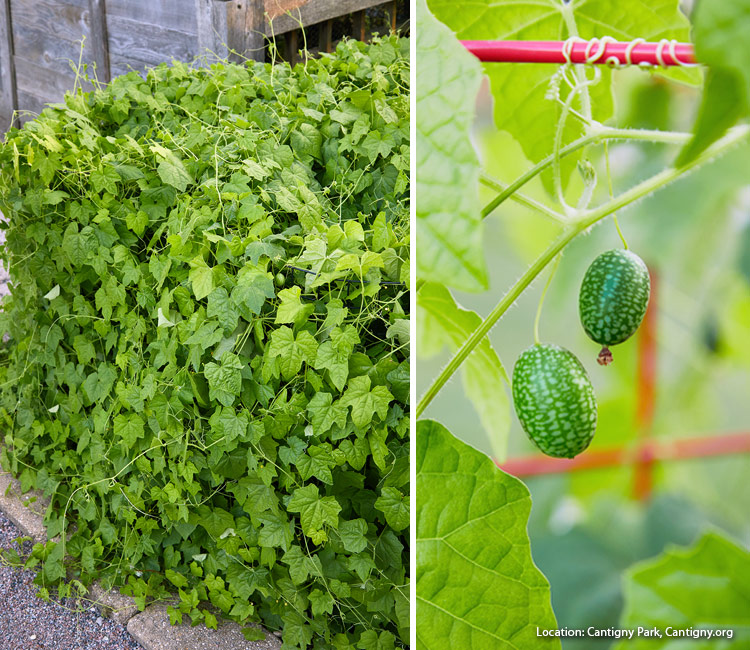The Benefits of Adding Cucamelon Plants to Your Garden
Do you ever find yourself wandering through the garden aisle, tired of planting the same old tomatoes, carrots, and lettuce in your backyard? If you’re looking to add an extra layer of excitement to your homegrown harvest, the darling cucamelon is here to revitalize your green space. These grape-sized fruits, with their adorable watermelon-like appearance, pack a punch of refreshing cucumber and citrus flavors, elevating your summer salads to new heights. But fear not – the journey to a delectable cucamelon garden doesn’t need to be intimidating. In fact, these resilient plants offer a host of benefits that make them an ideal addition to any gardening endeavor, be it small pot projects or expansive backyard transformations. In this blog post, we will explore the various advantages of embracing this charming, drought-tolerant plant, and how cultivating cucamelons can bring a burst of joy and a plethora of health benefits into your life. So, buckle up fellow garden enthusiasts, and get ready to be smitten by these cute, low-maintenance, and enormously versatile cucamelon plants!

Cute and Nutritious: The Cucamelon Superfood
Cucamelons, the adorable and nutritious superfood, have gained much popularity due to their unique appearance and impressive health benefits. This small fruit, resembling a miniature watermelon, belongs to the cucumber family and is packed with powerful antioxidants, including lycopene and beta-carotene. Apart from being nutrient-dense, cucamelons are low in calories, contributing to their superfood status.
Lycopene, a plant pigment that gives fruits their red-pink color, is known for its antioxidant effects, making it beneficial for combating inflammation and supporting brain health. Conversely, beta-carotene, a type of carotenoid found in fruits, converts to vitamin A in the body and plays a vital role in neurological function, vision, and skin health. Additionally, cucamelons are an excellent source of fiber, minerals, and vitamins such as K, E, and C.
Growing your own cucamelon plants at home provides a steady supply of this nutrient-rich superfood, adding an interesting and beneficial element to your garden and diet.
Growing Cucamelons: Tips and Tricks
Growing cucamelons, also known as Melothria scabra or mouse melons, can be a delightful and beneficial addition to your vegetable garden. These tiny plants produce grape-sized fruits that resemble miniature watermelons, with a flavor reminiscent of a cucumber but with a hint of lemon. Not only are cucamelons visually appealing, but they are also drought-tolerant, pest-resistant, and disease-resistant, making them an easy and low-maintenance choice for gardeners.
In order to successfully grow cucamelons, it is important to provide them with optimal growing conditions. Plant them in a location that receives plenty of sunlight and has well-draining, rich soil. Cucamelons can be grown in containers as well, provided they are at least 5 gallons in size. Supporting the vines with pea netting or other means will prevent them from overtaking your garden and keep them looking tidy.
Cucamelons have numerous health benefits, such as being rich in lycopene, beta carotene, and various vitamins and minerals. Furthermore, they are self-pollinating, meaning they don’t require assistance from other plants to produce fruits. With their unique taste, visual appeal, and ease of cultivation, cucamelons are an excellent addition to any home garden.

The Low Maintenance Cucamelon Plant
The cucamelon plant (Melothria scabra) is a low-maintenance addition to any garden, offering both ornamental and nutritional benefits. Originating from Central America, this fast-growing climbing vine is known for its attractive heart-shaped leaves, buttery-yellow flowers, and tiny, watermelon-like fruits. Also known as “mouse melon,” “Mexican sour gherkin,” or “sandita” in Spanish, these small fruits boast a cucumber-like taste with a tangy citrus twist, making them a delicious and healthy choice for salads, salsas, and pickling.
It’s simple to cultivate cucamelons, as they are pest-resistant, disease-free, and fairly drought-tolerant. The plant is frost-tender, usually grown as an annual in cooler climates or as a deciduous perennial in warmer regions. While it prefers a sheltered spot with full sun, the cucamelon plant can be grown in containers, allowing gardeners to move it indoors during cold temperatures or harsh weather conditions. Overall, the cucamelon plant is a versatile, low-maintenance, and eye-catching addition to any garden space.
Cucamelons in the Kitchen: Eating and Drinking
Cucamelons, with their delightful appearance and unique taste, are quickly becoming a popular addition to various dishes and beverages. These tiny fruits, which resemble miniature watermelons, are packed with nutrients such as antioxidants, vitamins, minerals, and fiber. The taste of cucamelons is similar to conventional cucumbers but with a pleasant, tangy twist due to their hint of lemony flavor.
In the kitchen, cucamelons can be eaten raw straight off the vine or incorporated into more adventurous recipes. Their sour taste makes them a perfect accent for salsas, salads, and cocktails. For those looking for a refreshing salsa, swap out standard cucumbers for cucamelons to spice up the flavor profile. Alternatively, they can be pickled, enhancing their crispness and extending their shelf life.
Cucamelons also make a delightful addition to beverages, adding a refreshing cucumber-lime taste to drinks like martinis, mojitos, or simple infused water. Their cute appearance is not just for show—cucamelons truly bring a unique and healthful flair to a variety of culinary applications.

Health Benefits of Cucamelons
1. Packed with Nutrients: Cucamelons are rich in vitamins and minerals, including vitamin K, E, and C, which contribute to overall health and wellness.
2. Massive Antioxidant Power: These tiny fruits are loaded with potent antioxidants like lycopene and beta carotene, which support heart health, eye health, and youthful skin.
3. High in Fiber: The high fiber content in cucamelons is beneficial for digestive health, helping to maintain regular bowel movements and prevent constipation.
4. Low in Calories: Being low in calories, cucamelons are a perfect addition to weight loss diets or for those who want to maintain a healthy weight.
5. Reduces Cancer Risk: The antioxidants present in cucamelons help to neutralize free radicals and lower the risk of developing cancer.
6. Heart Health Booster: Packed with heart-healthy antioxidants, cucamelons can help to lower the risk of heart disease and stroke.
7. Unique and Delicious: Beyond their health benefits, cucamelons offer a unique taste that is a refreshing combination of cucumber and lime, making them a wonderful addition to salsas, salads, and cocktails.
Cucamelons: A Safe Option for Your Garden
1. Unique Appearance: Cucamelons are grape-sized fruits that resemble miniature watermelons. They add an interesting visual element to your garden and are fun to grow.
2. Flavorful Taste: These tiny fruits taste like cucumbers with a hint of tart sourness, making them a versatile addition to various dishes, salads, and cocktails.
3. Nutrient-Rich: Packed with vitamins and antioxidants, cucamelons offer numerous health benefits, similar to cucumbers and melons.
4. Low-Maintenance: Cucamelons can easily adapt to different soil conditions and have shallow roots. They require minimal care, such as regular watering and occasional fertilization.
5. Drought-Tolerant: These plants can withstand drought conditions better than cucumbers, making them a suitable choice for regions with a dry climate.
6. Pest Resistance: Unlike most cucumbers, cucamelons are rarely affected by insects and diseases, making them a safer option for your garden.
7. Container-Friendly: With a compact size and vigorous vines, cucamelons can be grown in large pots on a deck or patio, provided they have a support structure to climb on.
8. Easy to Grow: Cucamelons can be started indoors and transplanted after the risk of frost has passed, making them an accessible option for gardeners of all skill levels.
:max_bytes(150000):strip_icc()/GettyImages-1073914856-1d7b9410ce1e483ea4a569bfaf0c723c.jpg)
Multiple Names: The Cucamelon Hybrid
1. Adorable appearance: These tiny fruits resemble miniature watermelons and are a delightful addition to any garden.
2. Unique flavor: Cucamelons have a cucumber taste with a lemony twist, making them a refreshing snack or a novel ingredient in various recipes.
3. Disease and pest-resistant: Cucamelons are resistant to common issues like powdery mildew and aren’t affected by cucumber beetles or rodents.
4. Drought-tolerant: Native to Mexico and Central America, cucamelons have adapted to thrive in dry conditions.
5. Nutrient-rich: Packed with antioxidants, vitamins, minerals, and fiber, cucamelons promote heart health, maintain eye health, and support a youthful appearance.
6. Self-pollinating: These plants have male and female flowers, allowing for self-pollination and easy seed saving.
7. No cross-pollination worries: As a different genus from cucumbers, cucamelon plants won’t cross-pollinate with their cucumber cousins.
8. Rare: Not sold in stores, growing cucamelons at home is a unique opportunity to enjoy these cute and nutritious fruits.
Cucamelon Soil Needs and Care
Cucamelon plants, also known as Melothria scabra, are a unique and intriguing addition to any garden. These miniature, grape-sized fruits have a flavor similar to a cucumber but with a hint of lemony sourness. Not only are they visually appealing, but they also offer various health benefits and have a higher tolerance for drought and disease compared to traditional cucumbers. To ensure a healthy and fruitful cucamelon plant, it is essential to provide proper soil conditions and continuous care.
Cucamelon plants thrive in well-drained, slightly acidic, and humus-rich soil. Amending your soil with organic matter, such as compost, can help create the ideal soil environment for these plants. Additionally, covering the planting area with a layer of mulch will further help enhance the soil’s nutritional content.
As for care, cucamelon plants require at least six to eight hours of direct sunlight daily to produce fruit. They also need consistent watering, with at least one inch of water per week, focusing on the roots to avoid fungal growth on the leaves. During hot or dry spells, be sure to water more frequently to maintain moist soil conditions. Lastly, provide a trellis for the shallow-rooted vines to grow and ensure healthy fruit production. With proper soil conditions and diligent care, your cucamelon plants will flourish, adding an exciting and beneficial element to your garden.

Cucamelon: A Vine that Needs Space
Cucamelon, also known as Melothria scabra, is a unique vine to add to your garden that boasts numerous benefits. This drought-tolerant and disease-resistant plant, originating from Mexico and Central America, is capable of thriving in various climatic conditions and relatively unfazed by common pests such as cucumber beetles and squash borers.
The cucamelon plant is distinct from its cucumber relatives as it belongs to the genus Melothria, setting it apart in terms of growing characteristics and potential pests. It produces delightful, thumb-sized fruits that resemble tiny watermelons, with a flavor reminiscent of cucumber but with a zesty lemony finish.
Growing up to 10 feet in length, these vigorous vines require ample space and a sturdy trellis for support. However, the effort put into providing enough space is rewarded by the plant’s cold-hardiness and self-pollination abilities, ensuring a bountiful yield. Furthermore, cucamelon’s nutritional profile includes essential vitamins, antioxidants, and minerals, making this unusual vine a valuable and health-enhancing addition to your garden.
Harvesting and Storing Cucamelon Seeds.
Step 1: Identify Mature Cucamelons
Choose cucamelons that have reached their full size (approximately 3 cm long and 2 cm wide). The fruit should have a firm, thin skin and a juicy interior. Ideally, allow the selected cucamelons to remain on the vine until they are slightly overripe and start turning yellow; this ensures the seeds inside have fully matured.
Step 2: Extract Seeds from Cucamelons
Slice the mature cucamelons in half, and scoop out the seeds using a spoon. Rinse the seeds under running water to remove any remaining fruit pulp and debris.
Step 3: Dry Seeds Thoroughly
Place the clean seeds in a single layer on a paper towel or a fine mesh screen. Keep them in a well-ventilated, shaded area to dry for at least one week. Make sure they are completely dry before proceeding to the next step; otherwise, mold could develop during storage.
Step 4: Prepare Seeds for Storage
Transfer the dried seeds to an airtight container, such as a glass jar or sealable plastic bag. Add a moisture-absorbing packet, like those found in pill bottles or shoe boxes, to help maintain the seeds’ dryness during storage.
Step 5: Properly Store Seeds
Store the sealed container of cucamelon seeds in a cool, dark, and dry space, such as a cupboard or in the refrigerator. Under ideal storage conditions, cucamelon seeds can remain viable for up to five years.
By correctly harvesting and storing cucamelon seeds, growers can experience the benefits of growing this unique and tasty addition to their gardens for years to come.
FAQs
1. What are cucamelons?
Cucamelons are small, grape-sized fruits that resemble tiny watermelons but taste like cucumbers with a touch of tartness. Native to Mexico and Central America, they are packed with vitamins, antioxidants, and fiber, offering numerous health benefits. Cucamelons are also known by various names such as Mexican sour gherkins, mouse melons, or pepquinos.
2. How do I grow cucamelons?
To grow cucamelons, plant them in a sunny spot with well-drained, slightly acidic soil, during the spring season. Cucamelons need at least six to eight hours of direct sunlight daily and prefer warm temperatures. They benefit from some afternoon shade in hotter climates. Provide a trellis or stake for the vining plant to climb and ensure the soil remains consistently moist but never waterlogged.
3. Can cucamelons grow in colder climates?
While cucamelons do best in warm temperatures, they can be grown in colder climates by planting them in containers, which can be moved indoors during colder nights. They can also thrive in greenhouse conditions.
4. How can I use cucamelons in my cuisine?
Cucamelons can be enjoyed raw, straight off the vine, or used in various dishes such as salsas, salads, and cocktails. They can also be pickled for a unique twist on traditional recipes.
5. Where can I find cucamelon seeds?
Cucamelon seeds are available for purchase through various online retailers, such as and . You can also save your own seeds by harvesting them from ripe fruit, drying them, and storing them for future planting.
Conclusion
In conclusion, adding cucamelon plants to your garden not only provides a unique and visually appealing element, but also offers numerous benefits to your overall gardening experience. These indigenous plants have a long history of cultivation and use in their native regions, offering a new level of diversity to your garden. Their ease of growth, coupled with their natural resistance to pests, makes them an ideal choice for gardeners of all skill levels.
Cucamelons also contribute to a productive and bountiful harvest, yielding numerous miniature watermelon-like fruits that boast a distinct and tangy flavor. This versatile fruit can be enjoyed raw, pickled, or even in a variety of culinary dishes. The plants are adaptable to various climates, growing as annuals in colder regions and as perennials in warmer areas. With their hardy nature and high-yielding potential, cucamelon plants are a fantastic addition to any garden, providing gardeners with a new and exciting experience to enhance their horticultural practices.







